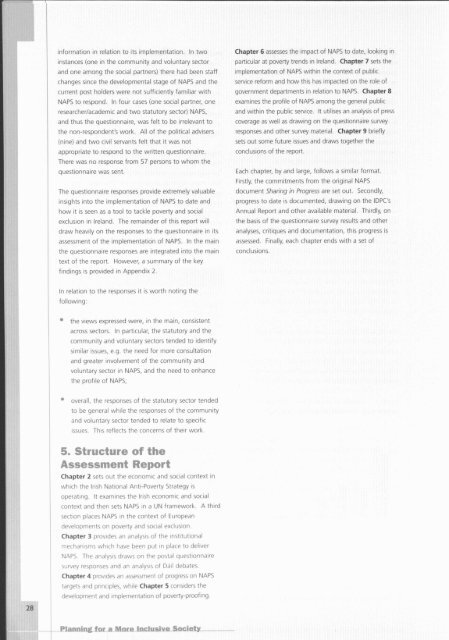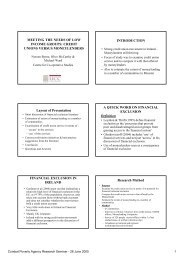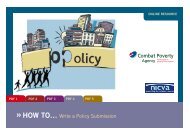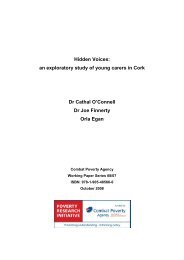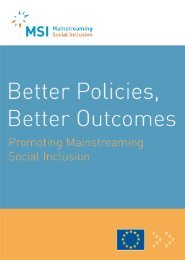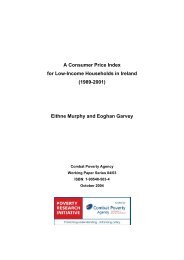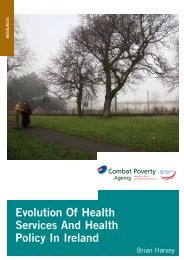Planning for a More Inclusive Society - Combat Poverty Agency
Planning for a More Inclusive Society - Combat Poverty Agency
Planning for a More Inclusive Society - Combat Poverty Agency
You also want an ePaper? Increase the reach of your titles
YUMPU automatically turns print PDFs into web optimized ePapers that Google loves.
in<strong>for</strong>mation in relation to its implementation. In twoinstances (one in the community and voluntary sectorand one among the social partners) there had been staffchanges since the developmental stage of NAPS and thecurrent post holders were not sufficiently familiar withNAPS to respond. In four cases (one social partner, oneresearcherlacademic and two statutory sector) NAPS,and thus the questionnaire, was felt to be irrelevant tothe non-respondent's work. All of the political advisers(nine) and two civil servants felt that it was notappropriate to respond to the written questionnaire.There was no response from 57 persons to whom thequestionnaire was sent.The questionnaire responses provide extremely valuableinsights into the implementation of NAPS to date andhow it is seen as a tool to tackle poverty and socialexclusion in Ireland. The remainder of this report willdraw heavily on the responses to the questionnaire in itsassessment of the implementation of NAPS. In the mainthe questionnaire responses are integrated into the maintext of the report. However, a summary of the keyfindings is provided in Appendix 2.In relation to the responses it is worth noting thefollowing:the views expressed were, in the main, consistentacross sectors. In particular, the statutory and thecommunity and voluntary sectors tended to Identifysimilar issues, e.g. the need <strong>for</strong> more consultationand greater involvement of the community andvoluntary sector in NAPS, and the need to enhancethe profile of NAPS;overall, the responses of the statutory sector tendedto be general while the responses of the communityand voluntary sector tended to relate to specificIssues. This reflects the concerns of their work.Assessmen? mebar*Chapter 2 sets out the economlc and soc~al context Inwhlch the lr~sh National Anti-<strong>Poverty</strong> Strategy ISoperating It examlnes the lr~sh economlc and soc~alcontext and then sets NAPS In a UN framework A thirdsection places NAPS in the context of Europeandevelopmrnts on povcrty and rocial exclusionChapter 3 provld~~ an rfnalysis of t h inst~tut~ondl~n,echanisrns wh~ch have bepn pot In pl,ic~ to del~verNAPSThp drlalys~~ dra~vs on the postr?l q~~esf~onnalresurvev responses and an analvsls of Dad debatesChapter 4 prov~des an assessment of proqress on NAPStarqets and prtnclples, wh~le Chapter 5 considers thedev~lopment and ~mplementation of poverty-proofingChapter 6 assesses the impact of NAPS to date, looking inparticular at poverty trends in Ireland. Chapter 7 sets theimplementation of NAPS within the context of publ~cservice re<strong>for</strong>m and how this has impacted on the role ofgovernment departments in relation to NAPS. Chapter 8examines the profile of NAPS among the general publicand within the public service. It utilises an analysis of presscoverage as well as drawing on the questionnaire surveyresponses and other survey material. Chapter 9 brieflysets out some future issues and draws together theconclusions of the report.Each chapter, by and large, follows a similar <strong>for</strong>mat.Firstly, the commitments from the original NAPSdocument Sharing in Progress are set out. Secondly,progress to date is documented, drawing on the IDPC'sAnnual Report and other available material. Thirdly, onthe basis of the questionnaire survey results and otheranalyses, critiques and documentation, this progress isassessed. Finally, each chapter ends with a set ofconclusions.Chapter 2: Economic and SocialContextThis chapter sets out the economic and social context inwhich the lrlsh National Anti-<strong>Poverty</strong> Strategy isoperating. The flrst section examines the lrish economicand social context, drawing on published statistics andviews from the postal survey. The second section setsNAPS in a UN context, the initial stimulus <strong>for</strong> thedevelopment of the Strategy. The third places NAPS inthe context of European developments on poverty andsocial exclusion.31. !wish Economic and SocialCon?extIn assessing NAPS ~t IS Important to set itslmplementatlon In the current economlc and soclalcontext Slnce 1997, when NAPS was f~rst Introduced,Ireland has experienced unprecedented economlcgrowth In fact, the country has susta~ned such hlghlevels of economlc growth that ~t IS no longer ranked asone of the poorer EU members Key features of currentlrlsh economlc growth Include the creatlon of new jobs,many of which are high-skill, high-wage and are beingfilled by young educated people; growth rates amongstthe highest In the world; until recently, low Inflation; anda real growth in incomes. Such a prolonged period ofeconomic success is unprecedented in Ireland.Furthermore, <strong>for</strong>ecasts suggest that there is no reasonwhy this growth should come to an abrupt end,although it is expected to slow down.The lrish economy has enjoyed six successive years Inwhich real GNP growth has been at least 6%, andGovernment debt has fallen from 95% of GDP to underof poverty. Secondly, consistent poverty has substantiallyfallen to under 10% of the population in 1997.Reductions in unemployment and poverty which mightonly have seemed aspirational in the early to mid 1990shave now been achieved. At the beginn~ng of the 2lstcentury we find ourselves in a much better economicsituation than we were in even when NAPS waslaunched in 1997. So the context in which NAPS ISoperating has changed and it is important that thischanging context is taken Into account in thedevelopment and implementation of anti-poverty policiesand programmes.It is important to recognise and acknowledge the greatstrides which have been made In poverty reduction InIreland in recent years, but to also recognlse that thesechanges are also bringing with them new issues andchallenges.What are these issues and challenges?1.1 The Mature of <strong>Poverty</strong> is ChangingIt is noteworthy that over three-quarters of therespondents to the ~ostal survev belleve that the currenteconomlc growth in Ireland is changing the nature andexperience of povertv However, fewer than ten per centof them believe that ~t 1s having a posltlve effect.Although Increased employment and a correspondingdecrease In poverty IS noted, the respondents'experience IS largely one of Increased Income dlsparltlesand a greater sense of soclal exclusion <strong>for</strong> those l~vlng onlow incomes. As one respondent commented:50% (Baker et al, 1999) Employment has Increased by335,000 between 1994 and 1999 to a level of more"Current growth is obviously having athan 1 5 m~ll~on (NESC, November 1999 3) In thepositive impact in that it is taking someperlod from Apr~l 1997 to late 1999 the unemployment ~eo~le out of <strong>Poverty</strong>, but it is alsorate dropped from 10 3% to 5 1 % whlle the rate oflong-term unemployment has decreased from 5 6% to2 1 % over the same per~od (CSO, Quarterly Nat~onalHousehold Survey, March 2000). Inflation has remalnedlow since 1997 (under 2.5%). untll recently, when ~tIncreased to 4.3% (CSO, Consumer Price Index Release,February 2000).What are the ~mpl~cat~ons of th~s economlc growth <strong>for</strong>poverty reduct~on In Ireland? Firstly, there has been acons~derable fall In unemployment, and part~cularly long-term unemployment, which IS known to be a key causecompoundin< the exclusion andstigmatisation of those still living in~overtv.... There is a sense that ... ir aperson is poor nowadays, it must be theirown fault."Income lnequal~ty 15 lncrraslnq as t h qap ~ wldrnsbetween those in work and those not In workweekly household Incomp rose subst~mtiC?lly, fromf 128 94 In 1994 to £ 156 96 In 1997 Mon~<strong>for</strong>inqAvc,rdqc<strong>Poverty</strong> Trends (1999) ~nd~cates that 7°/~-100~ of thepopulat~on are l~ving in consistent poverty (hard on'!annine <strong>for</strong> a <strong>More</strong> inclusive Societv. __-... _-_An-Initial Assessment of the-National Anti-<strong>Poverty</strong>-Straterlypart 2


